Matador Network's Blog, page 119
September 20, 2024
Protected: California Two Ways: Go Local With Airbnb Experiences in San Francisco and Los Angeles

This content is password protected. To view it please enter your password below:
Password:
Where to Eat and Drink in Baton Rouge, Louisiana’s Culinary Capital

Baton Rouge has a lot going for it. Louisiana’s capital city bleeds purple and gold as the home of Louisiana State University (LSU) and its nationally acclaimed Tigers football team. It houses the tallest capitol building in the country, alongside enduring architecture that charts centuries of history. Festivals, beyond Mardi Gras, keep the good times rolling all year long. And it all runs on a robust culinary scene that embraces the past, present, and future.
Baton Rouge’s culinary heritage is anchored in tradition, with deep Cajun and Creole roots, but the city also constantly adapts to new flavors and techniques. You’ll see this everywhere from small cafes to lavish restaurants. Whether you’re looking for iconic fare like boudin, crawfish, and sweet beignets or something more innovative, Baton Rouge is a city that’s best experienced through its food. Here’s where to go for a taste of the city.
Where to eat and drink in Baton RougeCoffee Call
Photo: Cristine Struble
Start any morning in Baton Rouge at Coffee Call. While the freshly brewed coffee or cafe au lait will add a little pep to your step, it’s the beignets that are a must-order here — specifically, the legendary beignet fingers. Cut into randomly shaped pieces, Coffee Call’s fluffy, slightly crunchy sweets are generously coated in powdered sugar, although tables also come with extra shakers. Expect to leave with a dusting of sugar on your shirt — it’s the sign of a well-enjoyed snack.
Coffee Call: 3132 College Dr, Suite F, Village Square, Baton Rouge, LA 70808
French Truck Coffee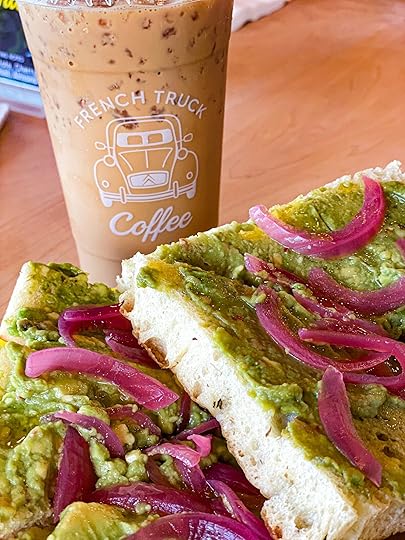
Photo: Cristine Struble
The locally roasted coffee at French Truck Coffee is a Louisiana staple. The chain’s version of chicory coffee over ice is a great option morning, noon, or night and pairs perfectly with a selection from the well-rounded pastry case or menu of savory breakfast dishes.
French Truck Coffee: 2978 Government St, Baton Rouge, LA 70806
Elise’s Plate and Pie
Photo: Cristine Struble
If you have the time to linger over brunch, Elise’s Plate and Pie is the perfect spot to enjoy a mimosa, coffee, and some Louisiana favorites. An icon in Baton Rouge, the award-winning restaurant was named after Chef Paul Dupre’s grandmother, Elsie Campeau Rupe, and that grandmotherly influence is present throughout the menu. Enjoy appetizers like fritters and hand pies, as well as savory pies like the seafood pot pie with delicate, flaky pastry and a cream sauce that’s decadent but not heavy. For dessert, go for a seasonal sweet pie, if possible.
Elise’s Plate and Pie: 3145 Government St, Baton Rouge, LA 70806
Poor Boy Lloyd’s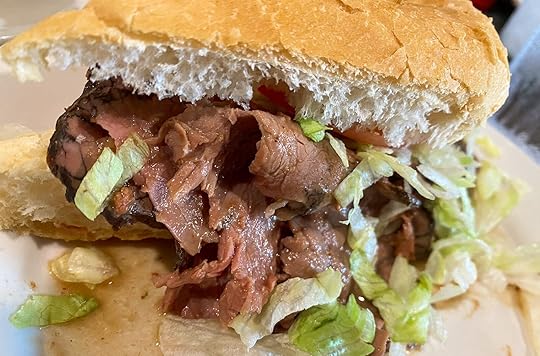
Photo: Cristine Struble
For lunch, Poor Boy Lloyd’s delivers some of the best po’ boys in Baton Rouge. Conveniently located downtown, the restaurant has been around for decades and seen an array of famous faces at its tables. It gives diners plenty to look at on its walls, too, although all eyes are on the plate once the food arrives. Try ordering the roast beef po’ boy as an alternative to the traditional seafood option — the beef is perfectly tender, and the au jus is quite flavorful.
Poor Boy Lloyd’s: 201 Florida St, Baton Rouge, LA 70801
Zeeland Street
Photo: Cristine Struble
Mondays in Baton Rouge are all about red beans and rice, a classic Creole comfort food. But the staple is available every day of the week at Zeeland Street, with or without sausage and with your choice of sides and a serving of cornbread. Altogether, the filling dish eats more like two meals than one. Rounding out the menu of this family-owned, local-favorite restaurant is a mix of daily specials and tried-and-true homestyle favorites.
Zeeland Street: 2031 Perkins Rd, Baton Rouge, LA 70808
Jubans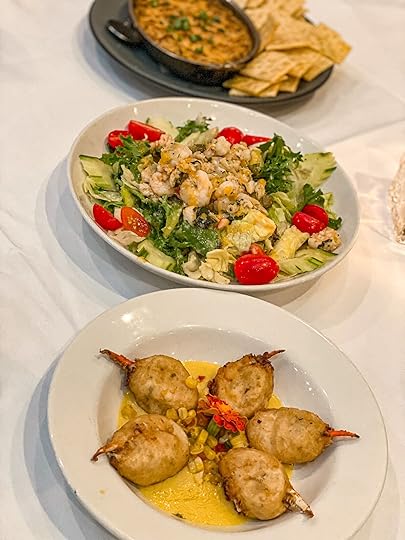
Photo: Cristine Struble
Jubans is the quintessential elevated dining experience in Baton Rouge. Reestablishing itself after a move and renovation, the vibrant space sets the tones for a superb dinner. Menu classics deliver the layered flavors expected from Louisiana cuisine. The redfish Adrian — topped with Creole meunière sauce, lump crab, and mushrooms — has been on the menu since the restaurant opened decades ago. For the photo op of the night, don’t miss the fried, soft-shelled Hallelujah crab, with a delicate batter and luscious Creolaise sauce.
Jubans: 3739 Perkins Rd, Baton Rouge, LA 70808
Mestizo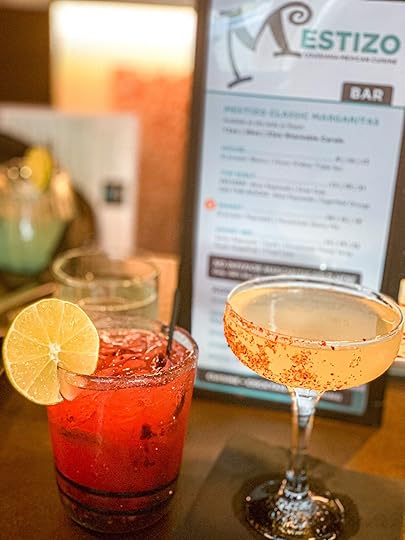
Photo: Cristine Struble
Mestizo serves a fusion of Mexican and Cajun-French flavors. From cocktails like the Louisiana Margarita that awaken your palate all the way through desserts like tres leches cake, the meal balances bold spices and subtle sauces. While the menu changes periodically, the restaurant’s signature combination plate, Cancun, is a celebration of the sea that’s always a hit. The restaurant is also inclusive of dietary restrictions, including vegetarian and gluten-free options.
Mestizo Louisiana-Mexican Cuisine: 2323 S Acadian Thruway, Rouge, LA 70808
Chimes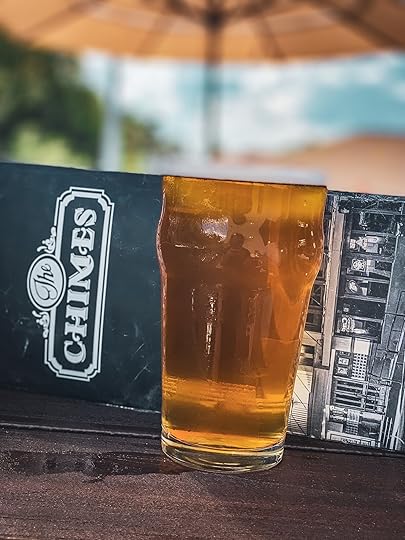
where-to-eat-in-baton-rouge
A Baton Rouge staple for 25 years, the original Chimes location near Tiger Stadium is one of the best places in town to grab a beer after an LSU game. Its robust beer selection ensures a frosty cold one for every preference, and there’s a long list of Louisiana-leaning pub grub to keep you sated while you quench your thirst.
Chimes: 3357 Highland Rd, Baton Rouge, LA 70802
BLDG5
Photo: Cristine Struble
Located under the Perkins Road Overpass, BLDG5 is the perfect spot to meet friends for a cocktail hour that extends into dinner. There’s a wide selection of crack cocktails, beer, and wine, as well as shareable boards. These menu items are far from simple charcuterie platters — one option includes a mash-up of cuisines including Korean chicken wings, shakshuka, and burrata. At BLDG5, cocktail hour lingers into dinner and no one will be looking at their watch.
BLDG5: 2805 Kalurah St, Baton Rouge, LA 70808
Oxbow Rum Distillery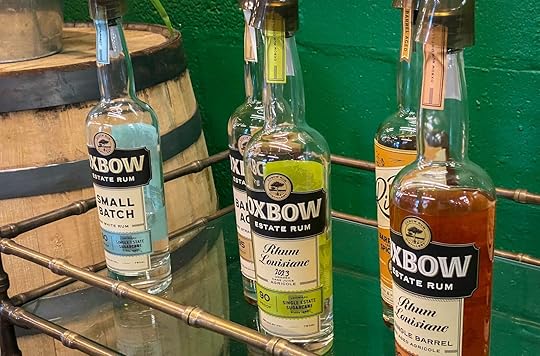
Photo: Cristine Struble
The Oxbow distillery produces award-winning rums and the official rum of LSU. Cozy up to the bar and go for a tasting. With six selections, the guided discussion showcases the craft and care that the local distillery puts into its spirits. Don’t miss the Rhum Louisane, a unique distillation that could convert bourbon drinkers to the cane sugar spirit.
Oxbow Rum Distillery: 60 Saint Phillip St, Baton Rouge, LA 70802 
Here’s How the Alaska-Hawaiian Merger Could Affect Your Future Flights

The months-long effort to merge two major airlines finally went through on September 18, marking one of the largest airline mergers of the last decade in the US.
According to the official announcement of the Alaska-Hawaiian merger, the $1.9 billion acquisition of Hawaiian Airlines by Alaska Air Group (which operates Alaska Airlines) will “enable guests to reach 141 destinations directly, including 29 international markets, and over 1,200 destinations globally through the oneworld Alliance and global partners.” The merger was announced in December of 2023 but was delayed as it went through review by the US Department of Transportation (DOT). Critics feared the Alaska-Hawaiian merger would reduce competition, leading to fare increases and a higher risk of inter-island routes being cut. Combined, the two airlines have a sizable share of flights between the mainland US and Hawaii, meaning a consolidation could drive up prices.
View this post on Instagram
A post shared by Alaska Airlines (@alaskaair)
While the DOT ultimately okay’d the acquisition, it did impose a few specific conditions: Alaska Air Group must maintain all frequent flyer benefits and rewards earned for Hawaiian Airlines frequent flyers, as well as a few essential routes between the islands. It also included a few more nuanced stipulations aimed at ensuring the merger wouldn’t block out future flight competitors or reduce airport convenience and access for local travelers.
The merger was especially controversial as the US already has an extremely small number of airlines that hold almost all the market share. In the 1980s, there were nearly 80 airlines operating in the US. But after decades of frequent mergers, government bailouts and payments, bankruptcies, and deregulation across nearly all aspects of the airline industry, just four major airlines (Delta, United, Southwest, and American) now control nearly 70 percent of the aviation industry in the US. After the new Alaska-Hawaiian merger, Alaska Air Group will represent an additional eight percent of the market. That leaves a roughly 20 percent market share for other airlines, making it very difficult for new airlines to compete. A lack of competition can lead to collusion, high prices, and limited travel options.
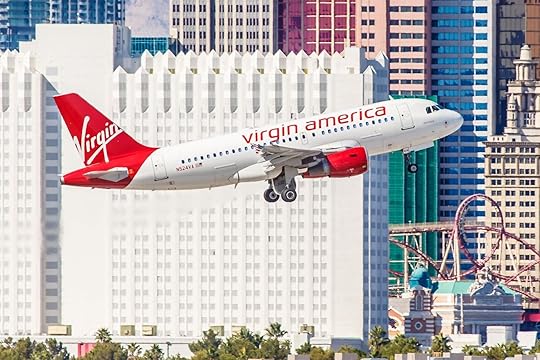
The last Virgin America-branded flight flew in 2018, following the 2016 purchase by Alaska Air Group. Photo: Eliyahu Yosef Parypa/Shutterstock
The last major merger between two US airlines occurred in 2016, when Alaska Airlines acquired Virgin America. That $2.6 billion purchase allowed Alaska to expand its presence in key markets like California and was seen at the time as the start of a plan to gain enough market share to compete with bigger airlines.
Alaska announced that for now, it intends to preserve the branding and regional identity of Hawaiian Airlines and is not planning to rebrand the airline as part of Alaska Airlines. However, the purchase will make Honolulu the second-largest hub for the airline, headquartered in Seattle.

Travelers will be able to book flights on both Hawaiian Airlines and Alaska Airlines via both airlines’ websites. Photo: Emil Kazaryan/Shutterstock
In the near future, you’re not likely to notice much of an impact of the merger if you’re flying either airline; full integration will likely take at least 18 months. In the next few weeks, consumer-facing integrations will allow frequent fliers to move their miles between airlines and spend miles on either airline, and travelers with lounge access on Alaska Airlines will be able to use the lounges when flying on Hawaiian Airlines. It’s unlikely any routes will be cut, as maintaining each airlines’ routes was a condition of DOT approval. Another upcoming change will be to the booking process, as travelers will be able to book flights on either airline through AlaskaAir.com and HawaiianAirlines.com.
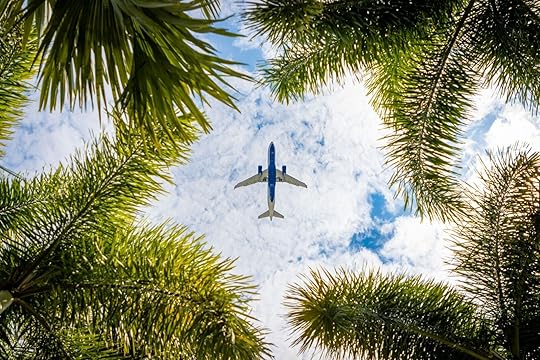
Photo: Ajax9/Shutterstock
For now, it’s hard to say what the impacts of the Alaska-Hawaiian merger will be for travelers. The only impact known for sure is that Alaska will be creating a new loyalty program that includes both airlines, likely to launch in mid-2025. “We’re working on combining the best of Mileage Plan and HawaiianMiles into a new unified loyalty program for our guests,” writes the press release, with no additional details released, as of September 19.
The DOT gave its blessing for the merger, but the actual process of merging is a slow one. Next steps include regulatory approvals from the DOT, requiring lots of paperwork and filings to received a “single operating certificate” from the Federal Aviation Administration (FAA), which it needs to operate the two airlines as one. Alaska will also need to meet conditions of the approval, like maintaining routes and ensuring frequent flyers don’t lose any benefits they’ve earned. Interestingly, there’s no expiration date on those conditions, and the DOT will likely monitor Alaska Airlines for several years to ensure compliance. But theoretically, those conditions could be lifted at any time, allowing Alaska Airlines to make decisions as it sees fit about what routes to cut or what to charge. 
Montana’s Aspens Are Turning Gold. Here’s Where to See the Best Foliage in the State

Fall is the ideal time to visit Montana if you’re looking to get away from the crowds and into nature. The shoulder season welcomes the colorful displays of foliage, crisp, clean air, rivers teeming with fish, and active wildlife. Because Big Sky Country is vast, we’ve put together some top spots to see fall colors in all their glory. From the shimmering golden tapestry of aspen groves and deciduous trees in the southwestern and central regions, to the golden hues of the wheat fields against the backdrop of the setting sun over the northern and easter plains, here are some of the best places to visit in fall and where to stay.
We hope you love the spaces and stays we recommend! Just so you know, Matador may collect a small commission from the links on this page if you decide to book a stay. Listed prices are accurate as of the time of publication.
What is the best time to visit Montana in the fall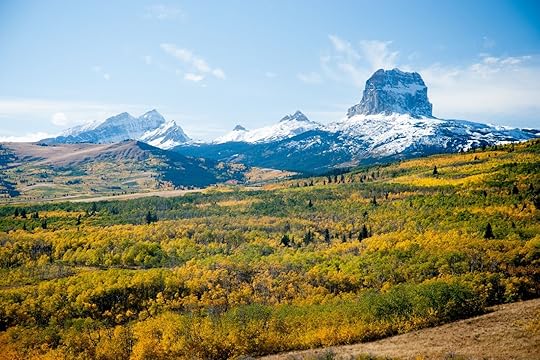
Photo: Visit Montana
The optimal time to visit Montana for fall foliage varies depending on the region. In general, the peak foliage occurs in September and early October, but check out this year’s forecast map for accurate predictions.
Northwest Montana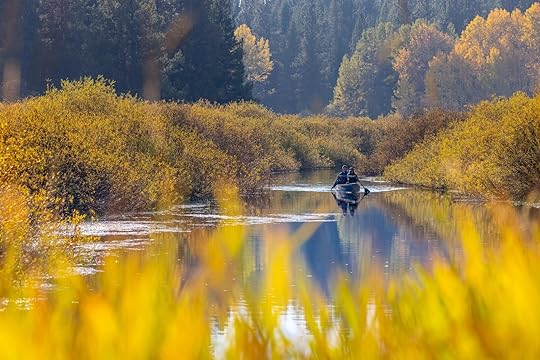
Photo: Amy Jimmerson
Northwest Montana offers many opportunities to witness the splendor of fall foliage and the shoulder season is also a great time for a road trip.
One of the better routes at this time of year is the North Fork Road, where you can enjoy the foliage of Glacier National Park on one side and Flathead National Forest on the other. A must-stop is North Shore Flathead Lake, the shoreline is adorned with yellows and oranges, and it’s a great place to watch the fall migration of birds.
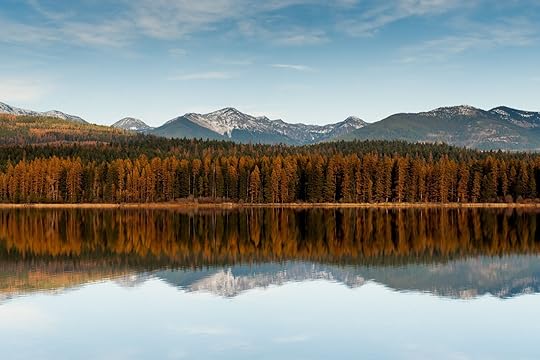
Photo: Visit Montana
Seeley Lake, in the heart of Montana’s Lolo National Forest, offers a breathtaking backdrop for hiking, biking, and other outdoor activities. For a light hike, consider the Seeley Lake Loop Trail. This route will treat you to scenic views of the lake and surrounding landscape. The lake’s calm waters also provide a peaceful setting for paddling, and several rental companies offer equipment and guided tours.
The Hungry Horse-Glacier View Ranger District is another excellent choice if you’re planning a road trip. Numerous larch trees were planted along the Hungry Horse Reservoir after the 2003 fires. The West Side Road (Forest Road 895) and the East Side Road (Forest Road 38) are beautiful picturesque drives with access to hiking trails, camping, and boat launches.
The Bison Range and the Mission Valley are also must-see destinations for fall foliage enthusiasts. The Bison Range, a wildlife preserve, offers stunning views of the surrounding landscape, while the dirt roads of the Mission Valley, particularly around Polson and Ronan, are lined with colorful trees.
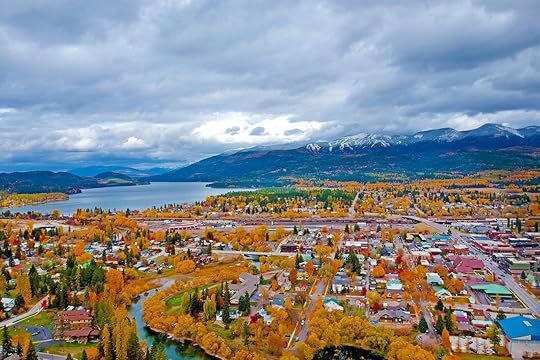
Photo: Explore Whitefish/Brian Schott
You might consider basing yourself near the popular ski area of Whitefish Mountain Resort on Big Mountain. During the off-season, the resort opens its hiking trails to the public, providing access to the remarkable display of golden larch trees.
Eastern Montana
Photo: Dan Armstrong
While the western part of Montana is renowned for its fall foliage, the eastern part of the state also offers something for leaf peepers. The Seven Sisters Wildlife Management Area, located between Sidney and Glendive along the Yellowstone River, is home to deciduous trees that showcase vibrant colors. The Hi-Line, a stretch of US Highway 2, is another excellent option for fall foliage viewing. Start in the Glasgow area and drive out to Tampico, then return to town along Riverside Drive Road and add stops in Malta, Chinook, or Havre for a full loop.
Traveling to Montana? Check out Matador’s Montana accommodations guides: Montana’s New Adults-Only Resort Is an Exclusive Luxury Experience in the Big Sky State 10 of the Best Hotels Near Glacier National Park Take a Fun Escape Into Nature at These Airbnbs Near Glacier National Park Live Out Your Inner Cowboy at These Rural Montana Farm Airbnbs 11 Missoula Airbnbs to Harness Montana’s Great Outdoors Why The Ranch at Rock Creek, One of America’s Priciest Hotels, Is More Affordable Than You Think Southwest Montana
Photo: Thomas Curry/Shutterstock
One of the most memorable ways to experience fall in Southwest Montana is a scenic drive along the Pioneer Mountains Scenic Byway. This picturesque route winds through towering mountains, carving a path through vast aspen groves. As you navigate the byway, bright shades of yellow create a seemingly endless tunnel of golden leaves.
Make a stop at one or more of the pristine lakes of Cliff, Wade, and Georgetown. The bodies of water reflect the fall colors of the surrounding landscape, creating a picture-perfect postcard moment.
For those wanting to stretch their legs and take in the colors, head to the Goat Flats Trail in the Anaconda-Pintler Wilderness. This moderately challenging hike, approximately seven to eight miles roundtrip, takes you through a landscape of forests, meadows, and mountain slopes. As you ascend the trail, the changing colors of the aspen and larch trees unfold around you, culminating in breathtaking panoramic vistas from the summit.
Central Montana
Photo: Teresa Otto/Shutterstock
One of the most picturesque places to witness fall foliage in Central Montana is along the Missouri River Corridor, stretching from Holter Dam to Fort Peck. The riverbanks are lined with cottonwood trees, which burst into yellows and oranges during the autumn months.
The Rocky Mountain Front, a dramatic range of mountains that separates the Great Plains from the Rocky Mountains, also offers breathtaking views of fall foliage. Golden aspens surround the rivers and creeks that flow through the region. As you explore the area, you’ll encounter a variety of landscapes, from towering peaks to meandering streams, all adorned with warm fall colors.
Central Montana’s rolling foothills and open prairies of Lewistown and other island mountain ranges may not have the same density of trees as the mountainous regions, but the shrubs and bushes that dot the landscape often change colors, creating a brilliant tapestry that complements the vastness of the prairies.
Where to stay in Montana in the fallFrom cozy cabins in the woods to rural farm stays, Montana has some stunning Airbnbs. Here are some of my top picks for fall.
Browse more Airbnbs in MontanaRaven’s Nest Treehouse in Columbia Falls
Photo: Airbnb
See more photos“There’s no roughing it,” with a stay in this fabulous two-story luxury tree house, says the host. It’s situated on five wooded acres and is only 30 minutes from Glacier National Park and minutes from Whitefish Moutain Ski Resort. So you’ll have the best of both worlds: A secluded retreat and proximity to some of the best places in Northwest Montana for fall foliage.
Four guests, two bedrooms
Price: $292 per night

Photo: Airbnb
See more photosThis home is situated on ABC Acres, a permaculture farm in the Bitterroot Valley of Western Montana. From the front porch, you’ll be surrounded by nature and animals, including chickens and goats, and witness the farm’s daily activities. It’s just minutes from the Valley’s small-town happenings, so expect fall harvests at farmers’ markets and seasonal celebrations.
Nine guests, four bedrooms
Price: $400 per night

Photo: Airbnb
See more photosSituated on a 230-acre working ranch, this rental offers a secluded and immersive farm retreat. Located just 40 minutes from the North Entrance of Yellowstone National Park and an hour from Bridger Bowl, Erik’s Ranch is a nonprofit organization operated by young adults with autism. For an additional fee, guests can participate in various activities, including guided snowshoeing in winter, horsemanship lessons, and fly fishing or rafting during warmer months.
Six guests, two bedrooms
Price: $336 per night

Photo: Airbnb
See more photosOnly 20 minutes from Helena in the mountains of Jefferson City, this boutique A-Frame has three bedrooms, a hot tub, two outdoor firepits and jaw-dropping mountain views. It’s an ideal place if you are touring the state in the fall and a perfect stopping point between Yellowstone and Glacier National Parks. 
Six guests, three bedroom
Price: $320 per night
September 19, 2024
I Spent Five Weeks in a High-Intensity Breathwork Course to Perform Better at High Altitudes. Here’s How It Went.

The thin, crisp air of the Colorado Rockies had always been a double-edged sword for me. It invigorated my spirit and fueled my passion for snowboarding, and eventually splitboarding, but it also challenged my body in ways I couldn’t fully comprehend. As a seasoned athlete, I knew the importance of acclimatizing, but I’d never quite felt like my breathing was in sync with how it should be.
Earlier this year I received a press release from Recal Travel announcing the launch of a high-altitude breathwork training course. Intrigued by the promise of unlocking my body’s potential, I signed up. This decision would lead me on a journey of a bit of self-discovery, a lot of breathwork transformation, and a newfound appreciation for the delicate balance between mind, body, and environment.
“I want you to be able to tolerate higher levels of carbon dioxide,” Anthony Lorubbio, founder of the Recal Travel, told me on our intro call. “We want you to feel less breathless on the mountain. You’ll be oxygenating your body more with higher levels of carbon dioxide.”
That’s because of the Bohr Effect, named after Christian Bohr, a Danish biochemist who was a pioneer in respiratory physiology. This refers to how changes in pH and carbon dioxide levels in the blood affect hemoglobin’s affinity for oxygen. In essence, hemoglobin releases oxygen more readily in tissues with lower pH and higher carbon dioxide concentrations, such as actively metabolizing muscles. This mechanism is crucial for efficient oxygen delivery to tissues. When you’re headed to place without much oxygen, like the high alpine, one needs to be able to optimize this effect to their advantage.
As a dedicated splitboarder and lifelong mountain athlete, taking advantage of the Bohr Effect is something I never knew I needed to do, until I met Lorubbio. To do this, I’d need to learn to breathe more slowly. To allow the oxygen to really spend time in the body. The course is designed to build mental resilience alongside breathing techniques. For me, both were critical. I’m a disciplined person with a seemingly rigid workout routine, and who recreates in the mountains about 100 days per year. However, my mind has gotten the best of me on long days in the field before, and this is something I’ve worked to overcome over the years through mindfulness meditation, journaling, and generally trying to slow my ADHD brain by a couple notches.
I signed up for the High Altitude Breathwork Course from Lorubbio’s company, Recal Travel, to help me accomplish this. Over the course of five weeks, I’d see progress through struggle, gain through giving in, and ultimately, come out as a better athlete. Here’s how it went.
Background on Anthony Lorubbio
Coach Anthony walks through the exercises via video, always with a gorgeous background. Screenshot taken from Recal Travel
Anthony Lorubbio is a certified Wif Hof Method Coach and a practitioner of proper breathwork. He’s gained some acclaim for, among other things, hosting a weekly “Monday Morning Breathwork” livestream on social media. His company, Recal Travel, exists to connect travelers to nature, and it does so through trainings, trips, and resources. Recal also offers a guidebook journal for adventurers as well as a basic hiking breathwork guide, each available on its website. Lorubbio and his company specialize in mindful travel and proper preparation for high-altitude adventures.
How the Recal High Altitude Breathwork Training Course works
Dashboard screenshot courtesy Recal Travel
Recal offers its High Altitude Breathwork Training Course in three tiers. There’s a PDF-only version for $75, an online version with videos and other content for $275, and a personal coaching version for $875. I signed up for the online version with the videos. This included an intro call with Lorubbio to discuss my goals and answer questions. The five-week course is divided into five segments, with the first four weeks featuring different exercises that build on what was done the previous week.
Exercises require physical activity, some of which can be done on a flat surface like a sidewalk while others require stairs or, since I live in a one-floor house with no stairs, a steep nearby hiking trail. Throughout the course I spent hours worth of time on the Palisade Rim Trail located just a couple miles from my house in Palisade, Colorado.
The final week mellows out to focus strictly on mastering Wif Hof Method breathing techniques without the physically straining aspects like steep hiking or running. Lorubbio invited me to a call prior to the fifth week to do a live instruction on Wim Hof Method breathing, which I’ll get into below.
After signing up and paying I was granted access to Recal’s online portal, the hub of the course. Here I found the five-week course broken down week by week, with videos and lessons for each week. Most are hosted by Lorubbio, breaking down elements of proper breathwork, explaining the exercises, and demonstrating them. Now and then, his co-leader Jacko makes an appearance in the videos to break down a highly technical aspect of the breathwork or guide Lorubbio through a live exercise as a demo.
Each day comprises about 30 minutes of exercises and training videos. There are options to go further, but I found that about half an hour was about the minimum daily commitment to feel like I was actually putting in what needed to be done. Some days took longer, depending on how far I decided to push the low-oxygen hiking.
The High Altitude Breathwork Training Course is built on improving a person’s score on three core breathwork tests:
BOLT, or Body Oxygen Level Test. This test requires taking a few calm breaths in a seated position, then plugging your nose and timing how long it takes before your body sends a panicked “I need to breathe” trigger, like an involuntary swallow, tensing of the neck muscles, or a contracting diaphragm. I lasted 14 seconds before starting the course, with the stated goal of the course to get me to between 25 and 30 secondsCO2TT, or Carbon Dioxide Tolerance Test. This test requires taking three relaxed breaths in a seated position, followed by a deep breath. At the top of the breath, you exhale as slowly as possible, for as long as possible. I hit 59 seconds before the course, with the goal to get to 80 secondsMaximum Breathlessness Test. This test measures the number of steps you can take during one breath hold after exhalation. I hit 41 steps before the course, with the goal to get to 80Beyond improving the score, the goals of the course, according to Lorubbio, are:
To develop proper breathing techniques while dealing with breathlessness, in preparation for high-altitude expeditioningTo make adaptations to your tolerance for CO2 sensitivity and create new red blood cellsTo strengthen the diaphragmGetting started: The first two weeks of the Recal High Altitude Breathwork Training Course
The first week eased me into the exercises. I’d done my three base assessment tests. Now it was time to do the work necessary to boost those scores. Lorubbio told me during the intro call that he’d be testing a new method with me, Respiratory Muscle Training, where I’d alternate between doing the exercises outlined on the platform and a couple of additional exercises he’d send instructions for each week via email. The primary exercises during Week 1 included breath holds and what’s called “Breathe Light Meditation,” a process that involves breathing lighter than normal for several minutes in a specific manner. The Respiratory Muscle Training exercises consisted of diaphragmatic breathing practices designed to grow your ability to maintain proper breathing at high altitude, where the air is thinner.
After working through the exercises for five days, I boosted my base assessment scores to:
BOLT: 18CO2TT: 1:01 (61 seconds)MBT: 55 stepsWeek 2 ramped up the activity a bit by adding H.A.S., or High Altitude Simulation. I spent much of the week on the Palisade Rim Trail near my house, working to strengthen the diaphragm through exercises that included walking with a plugged nose and breathing light while hiking uphill.
During this second week I began to notice certain things about my breathing patterns. I’m not certain whether they’re normal or not, and perhaps they’re the result of a lifetime of poor breathing technique at altitude. But I noticed that I had an easier time plugging my nose immediately after taking a breath and then continuing to move up the trail with full lungs (but not exhaling) and a harder time plugging my nose after exhaling. I also noted in my journal that hiking uphill without breathing is, without question, hard to do.
I pushed through the struggle over five days of training. I didn’t see the progress I was hoping for this week, and while I’d like to attribute that to the fact that the week included a few particularly hectic few days of work, the actual reason is likely that I simply need to work harder.
Heading into Week 3, I’d boosted my base assessment scores to:
BOLT: 21CO2TT: 1:02 (62 seconds)MBT: 57 stepsGetting into a rhythm: Week 3 of the Recal High Altitude Breathwork Training Course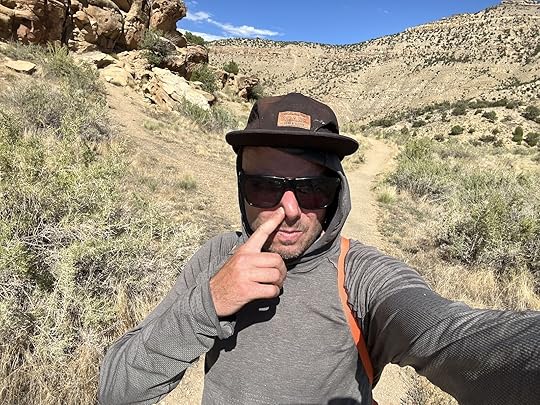
Working hard, barely breathing. Photo: Tim Wenger
Week 3 is when I really started to notice changes in my breathing. I’d by then become accustomed to having less air in my body and, somewhat counterintuitively, this began to seem normal. I felt this notably during the Rock and Roll Breathing exercise, which involved sitting cross-legged and rolling forward while exhaling to strengthen the inspiratory muscles, like the diaphragm, and expiratory muscles, like the abdomen, simultaneously. The week prior, it felt weird to breathe all the way out and then attempt to keep going. Now, it actually felt good to do so, leaning all the way forward to force out the final bits of breath through my diaphragm. I craved it. I began doing this exercise during other times of the day, for example, while watching my daughter eat a bowl of cereal in the morning I’d find myself trying to force all of the air out of my lungs. I probably looked ridiculous sitting at the kitchen table, though Olivia – typically quick to point out any irregularity that surrounds her – never said anything about it.
In the training videos for Week 3, Lorubbio notes the importance of maintaining mental composure while experiencing a lack of oxygen. The HAS bonus exercise this week, which involved briskly hiking for 20 minutes uphill with one nostril plugged, I struggled at first but after a few minutes found myself entering a “flow state” such as I’ve heard runners describe. I came to view this exercise as rather zen-like, and even enjoyable. As I moved through the training I felt this same flow pattern happen during some of the more repetitive exercises. Rock and Roll Breathing became the most impactful. I also flowed during Inverted Breathing, which required inverting myself and working through similar rapid breathing techniques.
It wasn’t all flowy goodness, though. Perhaps it was the 90-degree summer heat or the 5,000-foot elevation where I did the training, or maybe my lungs are just weak from being a smoker in my teens and early 20s. Whatever the reason, I struggled with the H.A.S. exercises that required slowly speeding up to a run while holding my breath. By Week 3 I did begin to notice small improvements day over day, but I never felt that I got close to the level Lorubbio described in the training video.
Breathe Light Meditation became the practice I felt most successful at. At first the task was awkward – breathing a short, quick breath and then exhaling it – while simultaneously trying to “clear the mind” to focus on these short breaths. I regularly practiced basic mindfulness meditation, and the shorted breathing felt counterintuitive to the long, slow breathing of the mindfulness practice. But after I became comfortable with it I was able to enter the same flow state and gain the same clarity.
Week 3 was my favorite in the course, and the point at which I made the most progress. My base assessment scores entering Week 4 were:
BOLT: 23CO2TT: 1:04 (64 seconds)MBT: 65 stepsClosing out the course
Upside down, barely breathing. Photo: Tim Wenger
On Wednesday of Week 4, I noticed a significant uptick in performance during my normal cardio workout at the gym. Where before I’d burn 13.5 to 14 calories per minute on an elliptical machine, I was consistently burning above 15 calories per minute without breathing more heavily, or seemingly exerting more effort. I also noticed that the exercises that required inhibiting my breathing resulted in cardio and stamina endurance exercises like biking and hiking, which are regular parts of my life, come easier.
Also this week I noticed my breaths had gotten considerably shorter during Breathe Light Meditation. I was better able to withstand the pain and enter the flow state. THe H.A.S. exercises this week were intense – a lot of running up the trail without breathing. I never felt great at it, but better than a couple weeks prior.
Week 5 was all about Wim Hof Method breathing. I hopped on a call with Lorubbio at the beginning of the week and he put me through a basic training. I was to do a few rounds of the method each day this week. Wim Hof Method Breathing put me into a state of calm awareness and clarity not unlike that obtained through meditation or yoga. I felt deeply engaged with the activity each day, able to disconnect even from immediate noises that surround me. I plan to work through a few rounds of Wim Hof breathing the next time I can’t sleep – rarely has an activity better calmed my mind.
I finished with base assessment scores of:
BOLT: 26CO2TT 1:21 (81 seconds)MBT: 83 stepsSo, was the Recal High Altitude Breathwork Training Course worth it?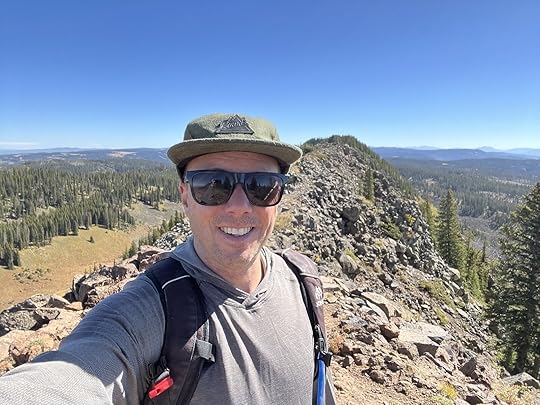
Summit selfie. Breathing normally. Photo: Tim Wenger
As a native Coloradan, I’ve long been (foolishly) quick to dismiss concerns of altitude sickness and generally feel comfortable at altitudes up to 14,000 feet. I’ve traveled the world in pursuit of mountains, from Kyrgyzstan to Turkiye to British Columbia. But if I’m honest, working through training exercises designed to improve performance in these environments is something I should have done a long time ago. I’m a heavy breather during strenuous exercise and have never been great at holding my breath. The first victory for me in this course was accepting that I needed this training as much as anyone. The biggest difference I’ve noticed since is in how I handle stretches of time without significant oxygen.
The course taught me to push through what I previously believed to be my breaking point, and on my first long trek through the high alpine, I noticed a significant improvement in my performance. After completing the course I embarked on the Crag Crest Trail on Colorado’s Grand Mesa, an intense 10.6-mile jaunt through the alpine to a spine-like scree field that gained 1,222 feet. That’s not a significant amount of elevation gain, but the trail starts at about 10,500 feet, climbs to the top of the crest, drops down, and then gains about 500 feet more throughout the trek – you’re not done climbing until you reach the trailhead at the end of the loop. I hoped to do the trail in under four hours.
I paid particular attention to my breathing during the steepest parts of the ascent. It was less heavy than on prior endurance treks. The flow state came quicker. Looking at my trip report on Gaia GPS, I rested for only nine minutes throughout the entire hike, most of which came when I stopped to scarf down a peanut butter and jelly sandwich after descending the ridgecrest.
On a splitboard expedition in Kyrgyzstan a couple years ago, I became intimately familiar with a pounding chest each time our group stopped to catch our breath in the high alpine of the Tien Shan. I felt traces of that here, but expected it to be worse – and I fully credit a stronger diaphragm and better breathing techniques for preventing that. As an aside, though I doubt there’s science to support this, I’ve come to believe that strengthening my diaphragm, and the internal pressures required to build that strength, improved my bowel movements. I felt that exercises like Rock and Roll Breathing cleaned me out, and this certainly improved my performance in the high country.
Unless you’re wearing equipment to measure breathing and heart rate up in the high alpine, it’s tough to know, metrically, how much a training course like this boosts your performance. But you can feel the difference – I did, emphatically. The base assessment scores tell a story of vast improvement for me, and beyond those numbers, the Recal High Altitude Breathwork Training Course left me with two very stark takeaways that further justify the effort it takes. First, I found new ways to enter a flow state through proper breathing and healthy pressure on my diaphragm. This undoubtedly will stay with me forever. Second, I’ll always have these exercises to turn back to and the knowledge gained throughout the course to help me prepare for future expeditions. Bring on the mountains. 
Camera Roll: A 5-Day Hiking Trip Through the Heart of the Icelandic Highlands

The first time I hiked Iceland’s 35-mile Laugavegur Trail — one of the most popular in the country and listed by National Geographic as one of the most beautiful in the world — was around two decades ago. It was a spontaneous decision, based on the realization that I could include it in my 2003 book Waking up in Iceland — a profile of the country’s prolific music scene that had steadily expanded into a travelog.
Truth be told, I had no idea about serious hiking back then. I pretty much just walked in what I had been wearing around Reykjavik while interviewing musicians: jeans, tee-shirts, and a heavy, non-waterproof jacket. I bummed a pair of hiking boots and a backpack that I panic-filled with heavy tins of fish and jars of pasta when I learned last-minute that there was no food en route. I also had to wade the trail’s glacial rivers barefoot because, obviously, I hadn’t done any proper research and hadn’t known about them. I honestly don’t know how I survived, but I did, and it blew my mind so much that I vowed one day to do it again.
An opportunity finally presented itself this year — it was time to finally make good on my past effort. I’ve learned a lot in the intervening years and this time I was accompanied by a friend, clad in technically appropriate clothing, carried a much lighter pack loaded with dehydrated food, and even bought a fancy pair of water shoes for the river crossings (my memory couldn’t erase the screams). If anything, this second time around felt even more mind-blowingly diverse than I remembered. The weather played ball for the most part, and the four days passed in a glorious and otherworldly parade of rhyolite mountains, fields of twinkling obsidian, geothermal springs, snow-capped glaciers, endless lava meadows, and stretches of black sand — ending in the leafy embrace of the forested area known as Þórsmörk.
Combined with some superb side-hikes to glaciers and gorges, I managed to almost double the trek to 60 miles, and was still quietly devastated when it ended. As before, I made use of the trail’s cabins along the way, which are all owned and maintained (as is the trail itself) by the wonderful team at Ferðafélag Íslands, the Iceland Touring Association. The huts are basic but have everything you need — hot water, heating, toilets, other hikers — and there are camping grounds at each one if you prefer to tent.
Although the trail is located deep in the highlands, it’s easy to get to and from during the hiking season (roughly between late-April and mid-September, approximately), thanks to bus companies such as Reykjavik Excursions, which took around 3.5 hours to get me to the starting point of the hike at Landmannalaugar, and runs services back to the capital from Þórsmörk.
The entire trail is so well marked it seems almost impossible to get lost but occasional memorials along the route testify to how easy it can be to succumb to a tragic mix of bad luck and bad weather if you’re not careful; heavy fog or a snow blizzard can change everything in an instant, and these can occur in summer so be sure to follow the rules at all times. Other than that, definitely don’t forget your camera…or your wading shoes. 

After a 7 AM start from Reykjavik, we arrive at the Landmannalaugar basecamp around 11 AM. The second half of the ride is bumpy as we drive through lava fields along gravel roads, giving us a great introduction to the lunar-esque landscapes of the Icelandic highlands. The basecamp comprises sleeping huts, a toilet and shower area, a very welcoming information hut, and a covered outdoor dining area. The sleeping rooms are dorm-style: simple, sociable, and comfortable enough with heating and well-equipped kitchens. Photo: Paul Sullivan

The weather when we arrive is pretty decent — around 40-50 degrees, sunshine, and pale-blue skies. Some people hike the first section of the trail straight from the bus but we are spending the night here so that we can enjoy and explore the area a little. After a brief nap we take on a two-hour loop that takes us past steaming geothermal pools, craggy rhyolite mountains, an emerald lake, and flower-dotted fields — a perfect introductory walk. Afterwards we take a dip in the basecamp’s very own geothermal hot spring and enjoy a whisky nightcap. Photo: Paul Sullivan

The next morning is sunny, too. Whoop! Everyone in our hut is up early, making breakfast and preparing for the day ahead. We set off with our backpacks to begin the 7.5 miles of the first stage; not so long, but generally regarded as the toughest section due to many steep climbs that combine to take us to an overall elevation of 1640 feet. Photo: Paul Sullivan

Within no time we are all but alone in what seems like a whole new world. We marvel and mutter to ourselves as each peak or turn seems to reveal yet another landscape, from harsh lava fields to the graceful folds and pastel colors of the Brennisteinsalda volcano and nearby mountains. A biting wind keeps us company but the day stays sunny and largely peaceful. Photo: Paul Sullivan

An example of the rhyolite mountains that are unique to this area. Rhyolite is a type of volcanic rock that’s known for its rainbow-like color palette. Contrasting with the darker basalt lava of the highlands area, it’s formed from the varied mineral composition inside the rhyolite that, when oxidized, create a vivid palette of hues, from deep blues and purples to vibrant yellows, reds, pinks, greens, and yellows. Photo: Paul Sullivan
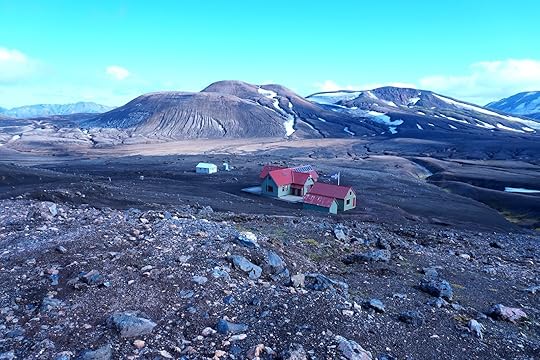
The huts at Hrafntinnusker look like toys amid the sprawling mountain scenery but after a tough three-to-four-hour walk, they’re a beautiful sight (even if the compost toilets are very far from a beautiful smell.) As before, the host — a Swiss guy who speaks fluent Icelandic — is very warm and welcoming. After a nap we take advantage of the ongoing sunshine to explore a nearby glacier. Photo: Paul Sullivan

We wake up the next morning to…snow! It has apparently been falling the whole night as everything is covered in a fairy-tale white dusting. It continues as we follow the second day’s section along the slopes of Reykjafjöll. Although the trail already starts to gently descend again after yesterday’s climb, this is not a downhill walk. It undulates constantly with several steep climbs to remind us of our sore calves from yesterday — and takes five hours to walk the same distance (7.5 miles.) Photo: Paul Sullivan
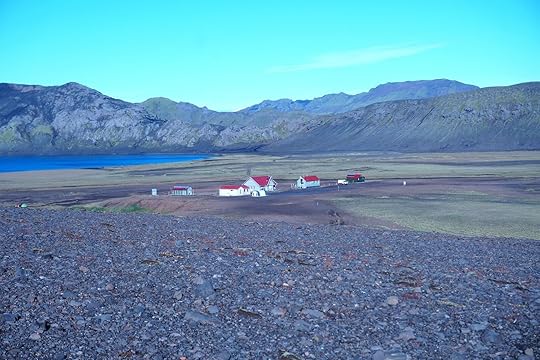
By the time we reach the pretty huts at Álftavatn, which are located right next to a picturesque mountain lake, the snow has stopped and the sun is back out. The wind is still fierce and cold but there are hot showers on offer! Do they cost a little extra? Yes. Are they worth it? Hell, yes! Photo: Paul Sullivan

The next day brings more cold sunshine. Given this is almost mid-September and the weather on this route is notoriously unpredictable, we cannot believe our luck. We begin the 10-mile stretch that is Day Three, heading out across a striking moss-covered lava landscape to reach a black-sand desert that stays flat for several miles. It lacks the dynamic diversity of the days before but our legs are grateful for it — and the surrounding scenery is far from dull. Photo: Paul Sullivan
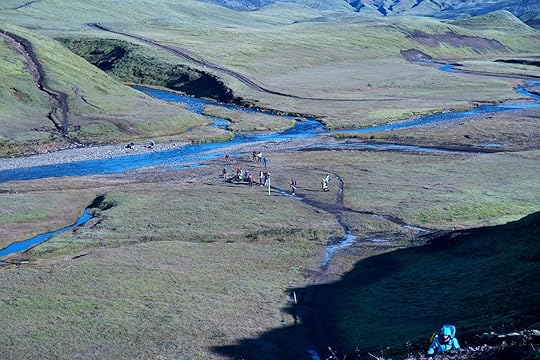
This third day also crosses the Bratthálskvísl river, where we get to finally test our wading shoes. It’s not a wide crossing but it is painfully cold, even with the shoes on. Photo: Paul Sullivan

We reach the huts at Emstrur feeling pretty good. Another nap and then we meet excited fellow hikers talking about a nearby gorge canyon that really needs to be seen. The hiking boots are back on again and we notch up a few more miles with a trail that traverses one side of an immense and highly photogenic canyon before looping back to the hut. As side-hikes go, this one is amazing. Photo: Paul Sullivan

Before we know it, it’s the final day. More sun but also more wind, scarily intense as we traverse the occasional high ridge. Once again we are taken through a black-sand desert and more moss-covered mountains until we eventually descend into the Langidalur valley in Þórsmörk. The wonderful thing about this final section is the increase in vegetation as you near the finish point. True, there’s one more river to wade but we are lucky as it’s quite shallow today (sometimes the melting glaciers push it to waist-height.) Photo: Paul Sullivan
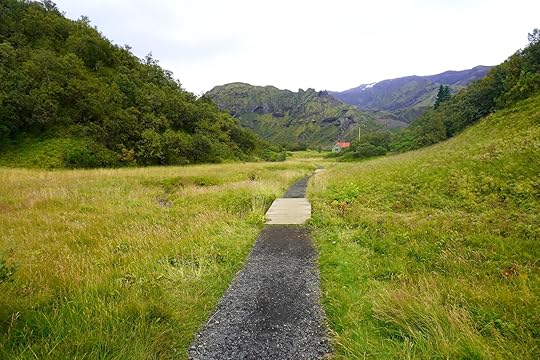
After the river, we enjoy the final couple of miles through the leafy Hamraskógar forest and reach the last hut with mixed feelings. In an ideal world we would continue hiking at least another few days, but it’s also good to be back to civilization. Luckily for us, we are picked up by the good people of Midgard Adventure, who feed us Icelandic hot dogs and bring us to their nearby basecamp hotel for a decent bed and a soak in their rooftop hot tub. Photo: Paul Sullivan
More like thisEpic StaysJaw-Dropping Iceland Airbnbs for a Bucket List Summer VacationJapan Airlines Are Offering Free Domestic Flights for Those Wanting to Explore the Country

To encourage travelers to Japan to get off the beaten path, delve deeper into the country’s cultural heritage, and venture beyond the popular tourist destinations, Japan Airlines is offering complimentary domestic flights all across the archipelago.
Reports of overtourism in specific areas of the country could also be a driving force behind the initiative. Places such as Shibuya’s scramble crossing, viewing spots for Mount Fuji, Kiyomizu Temple, and other sites in Kyoto are at capacity.

Photo: Richard Whitcombe/Shutterstock
“Japan may be both experiencing overtourism in some places and witnessing the opposite in others,” says the Japan Times.
By encouraging visitors to travel to other areas of the country, it’s hoped that tourist numbers will be more equally distributed across Japan’s thousands of islands.
The complimentary domestic flight offer has already been launched in some countries, with plans to expand its availability to the remaining destinations throughout September and beyond.
At the moment, the offer is open to passengers departing from the US, Canada, Mexico, Thailand, Singapore, Australia, and New Zealand. Those arriving from Vietnam and the Philippines can book from September 25 and Indonesia, India, China, and Taiwan from September 27.
To qualify, travelers must book an international ticket to Japan with Japan Airlines and a corresponding domestic flight in the same reservation. Separate domestic bookings will not be eligible.
A stopover fee of $100 will be applied to travelers coming in from the US, Canada, Mexico, and China if they stay in their first destination in Japan for more than 24 hours. Passengers from other countries will not incur additional charges for the domestic segments.
This could likely be an attempt to get travelers arriving in Tokyo out of the capital and into nature as quickly as possible.
To make the journey out to more remote areas seamless, the offer includes a generous free luggage allowance of 23kg across two bags.

UNESCO World Heritage Site Koyasan temple and Nachi Falls. Photo: fukez84/Shutterstock
The award winning airline recommends several domestic destinations, such as Hokkaido, known for its national parks and skiing resorts, and Wakayama, home to the temple enclave of Koyasan and Japan’s tallest waterfall, Nachi Falls. 
September 18, 2024
This Recently Revamped Colorado Springs Hotel Strikes Gold For Travelers

The Mining Exchange Hotel sits in the heart of downtown Colorado Springs, serving as a historic, revamped reminder that now matter how drastically the city has changed since its early prospecting days, some things have remained the same. Its name is a nod to the Centennial State’s “gilded past” — , having originally served as the city’s stock exchange for precious gold and silver in its heyday. Back then, it quickly became a local hangout spot for those seeking to strike it rich (and those already wealthy). Inside, the atmosphere is ritzy and refined but not unapproachable. Stepping into the lobby is like partaking in a living history film as it’s playing out right in front of your eyes.
Visitors check in and out at the regal front desk, made of strong dark wood and complemented by a brick backdrop dotted with real keys (but you’ll get an electronic key card, one of the many modernities this property has incorporated into its contemporary offerings). The floor-to-ceiling windows in the lobby let in an abundance of sunlight, which brightens the space and makes it feel warm, airy and welcoming. Being inside this building feels like entering into a more sophisticated, traditional era of travel — almost as if I should’ve worn my finest “dress clothes” (instead of my yoga pants).
The lobby is an enormous, open room furnished with a collection of various cozy but classy seating arrangements. It’s more like an opulent version of a community living room than a hotel lobby. Other timeless design elements like hardwood floors and exposed brick make the space feel smart and elegant. Also, in the lobby, folks can find a collection of historic artifacts, such as mining stock certificates, to see into the living history of this transformed space.
I appreciated how the redesign team was mindful to preserve the elements on-site that made the original property special, such as the vault doors, which have been transformed into modern day “housekeeping supply vault” doors.
Dining and drinking at The Mining Exchange Hotel
Traveling to Colorado? Check out Matador’s Colorado accommodation guides to the best places to stay across the state: 11 unique Airbnb Colorado rental homes for your next group getaway 10 Airbnb Estes Park rentals near Rocky Mountain National Park These Denver airport hotels put you close to the terminal with luxe amenities The best Airbnbs in Denver for beer, 420, and mountain culture Vail Airbnbs that make you feel like you’re in the heart of Bavaria Aspen Airbnbs to chill like a celebrity Stay near Garden of the Gods and Pikes Peak at these Colorado Springs Airbnbs These Airbnbs Near Telluride Offer an Authentic Mountain Getaway 10 boutique, luxurious, and trendy Denver hotels

Photo courtesy The Mining Exchange Hotel
There are currently two newly unveiled food and beverage concepts at The Mining Exchange Hotel, with still more to come in the future. Visitors can quench their thirst for a craft cocktail at Golden Hour, with decor that’s said to be inspired by the gilded era of this building back when it was a buzzing stock exchange. This venue encompasses an abundance of indoor and outdoor space. One side of Golden Hour’s bar is indoors — and its counterpart on the other side of the wall is outdoors, in the courtyard. The ambiance in both areas draws inspiration from the peaceful, enlightening feeling experienced when the light shines into the space at the “golden hour” times of day, surrounding sunrise and sunset.
The brick-bound, gold-accented indoor bar sparkles (literally and figuratively) with a menu of craft cocktails, beer, and wine alongside a selection of bites ranging from light options such as a charcuterie board to a full meal, like a cheeseburger.
Those seeking fresh air can sip al fresco surrounded by stone and brick in the alleyway on the other side of the lobby’s walls. The gorgeous courtyard space out back is intimate and secluded but spacious enough to soak in the night’s fresh air — I didn’t want to leave it. On Thursdays, jazz fans can revel in live jazz music hosted in partnership with Dizzy Charlie’s — a local music curator that organizes jazz pop-ups throughout Colorado Springs.
Caffeine fix at BLK MGK
Photo courtesy the mining exchange hotel
Open from 6 AM to- 4 PM daily, the property’s on-site coffee bar, BLK MGK, feels like more than just a standard coffee shop. And it does serve as more than just a coffee shop when the space hosts events like weekly programming including ”aura and astrology” readings and guided coffee tastings.
The shop proudly uses locally roasted beans sourced from Hold Fast Coffee Co., an innocent sort of contraband they appropriately label as the “other black gold.” Visitors can choose from a diverse breakfast and lunch menu that features a range of choices from standard drip coffee to seasonal lattes (they call these “potions”) with fun flavors. I had the “pumpkin s’mores” seasonal latte, and it did not disappoint. There are also fresh pastries, small bites and sandwiches like the “Tiramisu Brioche” which is topped with whipped ricotta, coffee cream and cocoa, and Jambon Beurre — and a generous menu of cooked-to-order breakfast and lunch selections.
My personal favorite part of the selection were these offerings that make this spot feel a bit more unique than just a standard coffee stop. The “tincture menu” lineup features a selection of everyday remedies, like “detoxing” activated charcoal drinks and “tummy tame” assorted bitters, which can be added to any beverage.
Even though I’m trying to do Sober September (so I didn’t really require this particular concoction this time around), I tried the “Hangover Helper Latte,” which is made with a slightly sweet and soulful blend of Earl Grey tea, steamed almond milk, and charcoal foam. Those who do desire to imbibe can try one of their coffee-based cocktails or locally sourced craft beers and wines by the glass.
Both of these dining and drinking establishments are open to the public to enjoy with no reservation needed. While I was there, it was nice to see this space is clearly a hangout spot where locals come to spend time and grab a drink for a classy night out on the town.
Guest rooms at The Mining Exchange Hotel Photo courtesy the mining exchange hotel
Photo courtesy the mining exchange hotel Photo courtesy the mining exchange hotel
Photo courtesy the mining exchange hotelThere are 128 recently revamped guestrooms that pay homage to the history of this storied destination, with rates from $230 per night. I was in awe at the high ceilings, white oak flooring, and large double-paned windows (don’t worry, the outdoor elements won’t get to you, here, despite the property’s golden oldie age), which made my room feel bigger and brighter. The exposed brick and naturally inspired art add a touch of nostalgia — and each guest room features its own commissioned work of art from native Colorado Springs plein air painter Emma Kelly.
I was told there are six different types of wallpaper that cover the wall space behind the beds, too, meaning you could stay overnight six different times, and have a completely different guest room experience during each visit. The timeless but traditional furniture in each room includes pieces such as custom wingback armchairs, colorful rugs, sturdy oak desks, a Victrola Bluetooth speaker (I loved how the radio was set on a local radio station when I walked into my room), a flatscreen television, and comfortable, clean beds.
The bathrooms — which I’ve heard claim to be “Insta-worthy” and do say I agree based on my experience — are adorned with vibrant green porcelain tilework, marble-topped vanities, bronze fixtures, a sleek walk-in shower, and sometimes even a delightful soaking tub. Room categories are labeled “Bronze, Silver, and Gold” as they relate to their square footage, in tribute to some of the minerals that originally made this region notorious.
On-site programming, activations, and amenities
Photo courtesy the mining exchange hotel
This property will also be a space for local artists to showcase their work, in “The Vault” — an on-site, rotating art gallery. It’s currently a stop on the city’s year-round First Friday gallery tour. Art enthusiasts who want to make their stay exceptionally special can purchase the “Peaks & Paintbrushes” package to indulge in a self-guided art experience inspired by the work of Emma Kelly and other original plein air artists. Upon check-in, they’ll get art supplies and suggestions for specific picturesque spots across Colorado Springs to paint.
Crystal nerds like me will agree with one of my favorite potential parts of a visit — the “crystal concierge.” This in-room wellness inclusion is the opportunity to personalize your stay and add a touch of magic to the experience. Guests just stop by the front desk or call down to request a healing stone to be delivered to their room, which they can keep for their stay (many of which were locally mined in Colorado).
For a more literal and less metaphysical sort of healing service, there’s a full-service spa nestled underneath the hotel offering more traditional “potions and remedies” for visitors and locals, including massage treatments, nail services, a steam room and sauna, and a salon. The existing full-service spa is currently open, but it’s also set for an upcoming refresh. Adjacent to the spa, there’s a compact underground fitness center for those who want to get in an indoor workout while on the road.

Photo courtesy the mining exchange hotel
Pet-friendlinessI brought my pup to experience this storied property with me, and I think he had just as much fun as I did. When we arrived at our room, dog treats and bowls were waiting for us to use throughout our stay. Even though we self-parked, the valet folks were incredibly kind when we walked into the lavish lobby space and asked if they could give him a treat (how could I say no?).
I actually forgot the dog bed I had brought with me from home in the room — and I didn’t realize it until we got back to my apartment in Denver. But I called the hotel, and they set it aside so I could drive back and pick it up the next day. Luckily, Denver is just about an hour north of Colorado Springs, so it wasn’t too much of a trek — but my dog wasn’t very happy to be without his bed for even just a single night, so I’m very grateful their on-site team for being mindful enough not to get rid of the dog bed as soon as we’d departed.
Other things to do in townThis property is located in a location that’s central to everything a visitor would likely want to explore while visiting town. It’s 15 minutes from Garden of the Gods, 20 minutes from the new Ford Amphitheater, 70 minutes from the tip of Pikes Peak, and walkable to the many shops and restaurants of downtown such as The Exchange On Tejon—which is one of my favorite coffee shops on this Earth. I’d recommend a stay for those who want a staycation, are traveling for a vacation, or just seek a unique upscale overnight experience in downtown Colorado Springs. 
How to Make Sure Your Next Cruise Isn’t Ruined by Screaming Children

Nobody wants to go on a cruise where there are hundreds of children. Even parents with small kiddos would rather not be among so many munchkins. That’s because, as lovely and entertaining as children are, they are also loud and boisterous (as they should be) making rest and relaxation almost impossible, not only for their parents but for everyone around them. And if there’s one vacation type that’s all about unwinding, it’s cruising, so why not try to do everything in your power to avoid kids during your next sailing?
Look at the calendar closelyIn the past two years, I’ve been on six cruises with five different cruise lines and I’ve learned about the best times of the year to cruise without being surrounded with kids.
It goes without saying that taking a cruise outside of school holidays is the most surefire way to not be bothered by the presence children. June, July, and August are obvious no-gos, while January, May, September, October, and early November are great options.
“On average, September and October have fewer family bookings versus the months of June through August on Norwegian Cruise Line ships for guests who want to sail with less children on board,” a spokesperson for Norwegian Cruise Line explained in an email.
I sailed the Mediterranean with Princess Cruises onboard the Sun Princess on the last week of May 2024 and while I can’t say that the ship was overrun with little ones, it certainly was the most children I’ve ever seen on a cruise.
Post-labor day cruises, like the cruise to Alaska that I took with Holland America in late September/early October in 2022, the Mediterranean sailing that I experienced with Oceania in November 2022, the circumnavigation of Iceland that I took with Atlas Ocean Voyages in September 2023, and the transatlantic crossing I did with Holland America in November/December 2023 were almost entirely devoid of children. That means that the pool was never packed with splashy, floaties-wearing mini tornadoes, that meals in the various dining venues were quiet, and that the activities and entertainment were focused on adults only, providing a huge variety of fun things to do at all times of the day and night.
Tricks to employ to avoid children while cruisingOf course, it’s not always possible to avoid the summer months, spring break, or the holidays. If you don’t have a choice but to cruise when you know there will be kiddos on board, there are some ways to dodge them.
The first is to book a longer cruise. As pointed out by cruisers on multiple Reddit threads, families with small children tend to go for shorter cruises (seven or eight-day sailings maximum), making longer voyages more adult centric.
The second is, when you can, to splurge for the exclusive onboard spaces, where the number of passengers are limited and where children are often persona non grata. On Holland America, that means signing up for Club Orange so you can have breakfast and dinner in a private venue. On Princess Cruises, you can pay for the Sanctuary Collection, which grants you access to a private restaurant, the private and adult-only Sanctuary Club with its own pool and cabanas, and the Suite Lounge a private space located on the top deck. On MSC, the Yacht Club, while not an adult-only area, is a retreat space that caters mostly to grown-ups with a private restaurant and pool, and exclusive services, reserved to few passengers. Carnivals cruise ships have their Serenity Adult-Only Retreat and Royal Caribbean’s have the Solarium, a retreat space for 18-plus passengers.
Not every cruise line, or cruise ship, offers exclusive, kid-free spaces, however. If you’re totally averse to spending any time being surrounded by children, look at adult-only cruises.
Adult-only cruisesThe only two cruise lines that advertise themselves as adult-only are Virgin Cruises and Viking Cruises. They have vastly different offerings and atmospheres, and, as such, attract a very distinct clientele.
There are many cruise lines that don’t explicitly say that they don’t accept children on board, but on whose ships you’ll never see any kids. Those are the cruise lines that don’t have any programs or activities for children on board, no playground, and skew towards a more mature, wealthy audience, including Oceania, Crystal, Ponant, Regent Seven Seas Cruises, and Silversea. Look at the ship you’re interested to travel on carefully and if you don’t see any children areas, waterslides, or bumper car rides, you should be in the clear.
River cruises and expedition cruises also tend to be off limits to children. For example, on its website, Scenic Cruises & Tours explains that “Luxury expedition style cruising is not recommended for children under 12. Guests under the age of 18 years must be accompanied by an adult and must share their accommodation with an adult. No children programs or babysitting services are available on board.” 
Vape Pens Can Catch Fire. That’s Why You Don’t Put Them in Your Checked Luggage.

Another day, another instance of vape pens catching fire. This time, the explosion occurred in the cabin of an EasyJet flight from Heraklion, Greece, to London, England, as passengers were still boarding. So now is probably a good time to remind everyone why those incidents happen and how to travel safely with a vape pen or e-cigarette.
Why do vape pens and e-cigarettes catch fire?Like most of our electronic devices, vape pens and e-cigarettes are powered by lithium batteries which, like the ones in our phones, laptops, tablets, smart watches, power banks, and the such, can overheat and even create sparks if they are “damaged, overheated, exposed to water, overcharged, or improperly packed,” the Federal Aviation Administration (FAA) explains. Not only that, but vapes pens also contain a heating element that can be activated by accident and lead to fires, says Transport Canada.
That’s why it’s strictly forbidden to pack vape pens, along with all other lithium batterie-powered devices, in your checked luggage. If a fire were to break out in the the luggage hold while in flight, it would be very hard to notice and therefore nearly impossible to contain. All lithium battery-powered devices, including vape pens and their spare batteries, must be packed in travelers’ personal belongings or carry-on luggage so that the users and the flight crew can have quick access to them in case of malfunction. Ideally, vape pens and e-cigarettes should be within arm’s reach.
According to the FAA, between March 3, 2006, and August 24, 2024, there have been 554 lithium batteries air incidents in the US, 118 of which are linked to vape pens and e-cigarettes. Vapes and e-cigarettes were the leading cause of lithium battery incidents on aircraft in 2022, of which there were 74.
What you can do to stay safeBesides never packing your vape pen, e-cigarette, and their spare batteries in your checked luggage, it is also imperative that all spare batteries be individually protected by either keeping them in their original packaging or in a bag. You can also use tape on the terminals of the batteries to keep them from short-circuiting.
Because there is a higher risk of fire when vapes and e-cigarettes are charging, it is prohibited to charge them on board a plane.
Like other lithium battery-powered items, if your vape pen or e-cigarette were to fall down in between the seats of an aircraft, do not try to remove it yourself. Ask a crew member, who is trained for such situations, for assistance.
And, of course, like traditional cigarettes, vape pens and e-cigarettes should never be used in an aircraft.
The infographic below, created by the US Food & Drug Administration (FDA), can help you choose a safer vape pen and use it as safely as possible, whether at home or while traveling. 

Photo: FDA
More like thisTravelWhy You Have to Tell a Flight Attendant if a Phone or Laptop Falls Between SeatsMatador Network's Blog
- Matador Network's profile
- 6 followers



